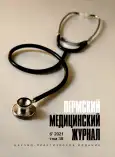Results of the use of selective adsorption of endotoxin in the complex treatment of surgical sepsis and septic shock.
- Authors: Vereshchagin A.1, Kotelnikova L.P.1
-
Affiliations:
- E.A. Vagner Perm State Medical University
- Issue: Vol 38, No 6 (2021)
- Pages: 16-24
- Section: Original studies
- URL: https://journals.rcsi.science/PMJ/article/view/78184
- DOI: https://doi.org/10.17816/pmj38616-24
- ID: 78184
Cite item
Full Text
Abstract
Objective. To estimate the results of the use of LPS-adsorption in the complex treatment of surgical or obstetric sepsis and septic shock and to determine the risk factors for the development of lethal outcomes.
Materials and methods. Since 2014, twenty-nine patients with surgical or obstetric sepsis and septic shock have been treated at the Perm Regional Clinical Hospital using selective endotoxin adsorption in addition to conventional medical therapy. Endotoxin elimination was performed using hemoperfusion with the Alteco LPS Adsorber (Sweden). The patients were divided into two groups according to the final results of the treatment. The data of clinical and laboratory examinations were compared before and 24 hours after LPS elimination.
Results. Based on the correlation analysis, the most significant risk factors for the development of fatal outcomes are identified. It was found that neither the initial scores on the APACHE, SOFA scale, nor the level of CRP, PCT, EAA have a significant correlation with the lethal outcome. The only indicator before LPS-adsorption that has a direct correlation of the average value with the fatal outcome is the initial dose of norepinephrine. In our study, the mortality rate depends on the decrease in SOFA scores and its components in 24 hours after the procedure. Patients with the lower score after LPS-adsorption would have lower mortality. The predictors of ineffectiveness of treatment, despite the LPS-adsorption, were an unreliable decrease in the dose of vasopressors and the level of PCT, light improvements in the oxygenation index, the presence of bacteremia, septic shock and the delayed procedure.
Conclusion. In surviving patients with surgical sepsis and septic shock, the use of LPS-adsorption in complex treatment significantly improved the function of the cardiovascular and respiratory systems, reduced the level of PCT. The risk factors for the development of lethal outcomes were the initial severity of cardiovascular insufficiency, the selective sorption of endotoxin with a delay, the presence of bacteremia, septic shock, insignificant decrease in SOFA scores and the level of PCT after selective sorption of endotoxin.
Keywords
Full Text
##article.viewOnOriginalSite##About the authors
Alexey Vereshchagin
E.A. Vagner Perm State Medical University
Email: veralex.80@mail.ru
ORCID iD: 0000-0002-1163-2316
Full-time postgraduate student, Department of Surgery with Course of Cardiovascular Surgery and Invasive Cardiology
Russian Federation, PermLudmila Pavlovna Kotelnikova
E.A. Vagner Perm State Medical University
Author for correspondence.
Email: hir.fpk159@yandex.ru
ORCID iD: 0000-0002-8602-1405
MD, PhD, Professor, Head of Department of Surgery with Course of Cardiovascular Surgery and Invasive Cardiology
Russian Federation, 614000, Perm, st. Petropavlovskaya, 26References
- Urakov A.L., Zolotuhin K.N., Samorodov A.V. Blood endotoxin level in patients with sepsis as an early predictor of mortality. Vestnik anesteziologii i reanimatologii 2018; 15 (3): 79–80 (in Russian).
- Podkorytova O.L., Vtorenko V.I., Vetsheva M.S. Selection of optimal modes of extracorporeal detoxification in patients with severe acute pancreatitis. Medicinskij alfavit 2014; 9: 12–16 (in Russian).
- Paternoster D., Nagi A. Immunomodulation, immunostimulation and extracorporeal hemocorrection in sepsis: the possibilities of using these technologies in cardiology. Vestnik anesteziologii i reanimatologii 2019; 16 (2): 96–100 (in Russian).
- Kulabuhov V.V., Chizhov A.G., Kudrjavcev A.N. Selective lipopolysaccharide hemosorption as a key link in pathogenetically justified therapy of gram-negative sepsis. Medicinskij alfavit 2010; 3 (12): 60–66 (in Russian).
- Jarustovskij M.B., Abramjan M.V., Krotenko N.P., Popov D.A., Pljush M.G., Nazarova E.I., Gordeev S.L. Experience of use of endotoxin selective adsorption in patients with heavy sepsis after open-heart surgery. Anesteziologija i reanimatologija 2014; 3: 39–46 (in Russian).
- Vatazin A.V., Fomin A.M., Koshelev R.V., Moskalec O.V., Zul'karnaev A.B. Endotoxin selective adsorbtion efficiency in a case of surgical sepsis. Vestnik transplantologii i iskusstvennyh organov 2008; 3 (41): 40–43 (in Russian).
- Vatazin A.V., Jarustovskij M.B., Fomin A.M., Koshelev R.V., Zul'karnaev A.B. The first experience of applying selective hemoperfusion in patients with surgical sepsis. Al'manah klinicheskoj mediciny 2008; 18: 22–29 (in Russian).
- Lipesey M., Tenhunen J., Pischke S.E., Kuitunen A., Flaatten H., De Geer L., Sjolin J., Frithiof R., Chew M.S., Bendel S., Kawati R., Larsson A., Mollnes T.E., Tonnessen T.I., Rubertsson S. Endotoxin removal in septic shock with the Alteko LPS Adsorber was safe but showed no benefits compared to placebo in the double-blind randomized controlled trial – the asset study. Shock. 2020; 54 (2): 224–231.
- Sartelli M. et al. The management of intra-abdominal infections from a global perspective: 2017 WSES guidelines for management of intra-abdominal infections. World Journal of Emergency Surgery 2017; 12 (1): 1–34.
- Adamik B., Zielinski S., Smiechowicz J., Kubler A. Endotoxin elimination in patients with septic shock: an observation study. Arch Immunol Ther Exp (Warz) 2015; 63 (6): 475–483.
Supplementary files






